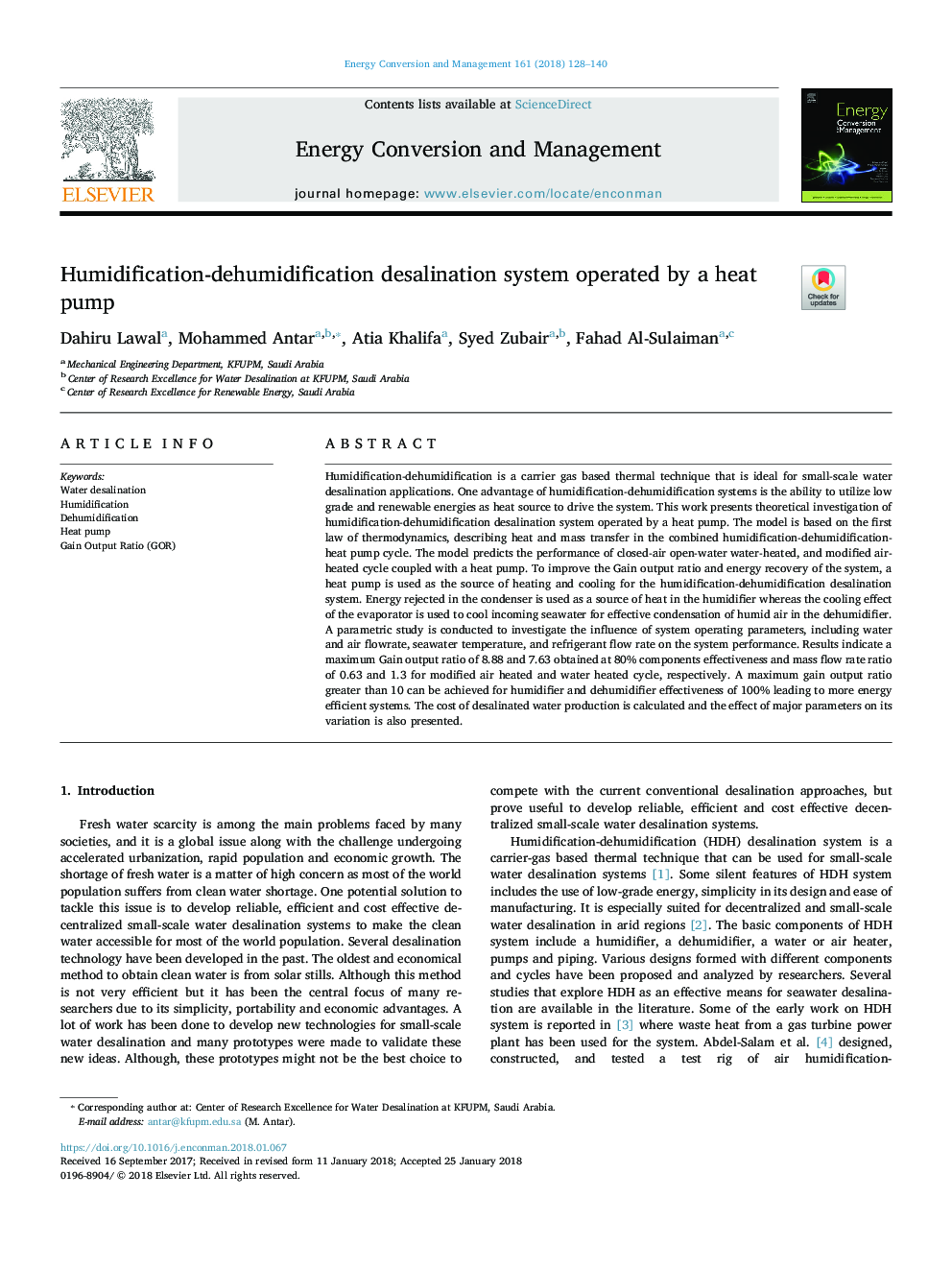| کد مقاله | کد نشریه | سال انتشار | مقاله انگلیسی | نسخه تمام متن |
|---|---|---|---|---|
| 7158921 | 1462801 | 2018 | 13 صفحه PDF | دانلود رایگان |
عنوان انگلیسی مقاله ISI
Humidification-dehumidification desalination system operated by a heat pump
ترجمه فارسی عنوان
سیستم آب شیرین کننده رطوبت - رطوبت سازی توسط یک پمپ حرارتی عمل می کند
دانلود مقاله + سفارش ترجمه
دانلود مقاله ISI انگلیسی
رایگان برای ایرانیان
کلمات کلیدی
ترجمه چکیده
رطوبت - رطوبت - روش حرارتی مبتنی بر حامل گاز است که ایده آل برای کاربردهای آب شیرین کننده آب است. یکی از مزایای سیستم های رطوبت - رطوبت ساز، توانایی استفاده از انرژی های کم انرژی و تجدید پذیر به عنوان منبع گرما برای راندن سیستم است. این کار تحقیق نظری را در مورد سیستم خلع سمزدایی رطوبت - رطوبت، توسط یک پمپ گرما انجام می دهد. این مدل بر اساس قانون اول ترمودینامیک است، توصیف انتقال گرما و جرم در رطوبت رطوبتی-رطوبت-مخلوط - پمپ گرما. مدل پیش بینی عملکرد چیلر آب گرم و چرخه هوای بسته شده با پمپ گرما را اصلاح کرده است. برای بهبود نسبت خروجی بهینه و بازسازی انرژی سیستم، پمپ گرما به عنوان منبع حرارت و خنک کننده برای سیستم آب شیرین کننده رطوبت-رطوبت استفاده می شود. انرژی که در خازن رد می شود به عنوان منبع گرما در مرطوب کننده استفاده می شود، در حالی که اثر خنک کننده بخار برای گرم شدن آب دریای ورودی برای تراکم موثر هوا مرطوب در رطوبت گیر استفاده می شود. یک مطالعه پارامتری برای بررسی تأثیر پارامترهای عملکرد سیستم، از جمله جریان آب و هوا، دمای دریا و جریان جریان مبرد در عملکرد سیستم انجام شده است. نتایج نشان می دهد که حداکثر نسبت توان خروجی 8/88 و 7/63 به ترتیب در میزان اثربخشی ترکیبات 80٪ و نسبت جریان جرم به ترتیب 0.63 و 1.3 به دست آمده است. نسبت خروجی حداکثر خروجی بیش از 10 می تواند برای رطوبت ساز و رطوبت ساز 100٪ به سیستم های با کارآیی بیشتر انرژی برسد. هزینه تولید آب شیرین شده محاسبه شده و تاثیر پارامترهای اصلی بر تغییرات آن نیز ارائه شده است.
موضوعات مرتبط
مهندسی و علوم پایه
مهندسی انرژی
انرژی (عمومی)
چکیده انگلیسی
Humidification-dehumidification is a carrier gas based thermal technique that is ideal for small-scale water desalination applications. One advantage of humidification-dehumidification systems is the ability to utilize low grade and renewable energies as heat source to drive the system. This work presents theoretical investigation of humidification-dehumidification desalination system operated by a heat pump. The model is based on the first law of thermodynamics, describing heat and mass transfer in the combined humidification-dehumidification-heat pump cycle. The model predicts the performance of closed-air open-water water-heated, and modified air-heated cycle coupled with a heat pump. To improve the Gain output ratio and energy recovery of the system, a heat pump is used as the source of heating and cooling for the humidification-dehumidification desalination system. Energy rejected in the condenser is used as a source of heat in the humidifier whereas the cooling effect of the evaporator is used to cool incoming seawater for effective condensation of humid air in the dehumidifier. A parametric study is conducted to investigate the influence of system operating parameters, including water and air flowrate, seawater temperature, and refrigerant flow rate on the system performance. Results indicate a maximum Gain output ratio of 8.88 and 7.63 obtained at 80% components effectiveness and mass flow rate ratio of 0.63 and 1.3 for modified air heated and water heated cycle, respectively. A maximum gain output ratio greater than 10 can be achieved for humidifier and dehumidifier effectiveness of 100% leading to more energy efficient systems. The cost of desalinated water production is calculated and the effect of major parameters on its variation is also presented.
ناشر
Database: Elsevier - ScienceDirect (ساینس دایرکت)
Journal: Energy Conversion and Management - Volume 161, 1 April 2018, Pages 128-140
Journal: Energy Conversion and Management - Volume 161, 1 April 2018, Pages 128-140
نویسندگان
Dahiru Lawal, Mohammed Antar, Atia Khalifa, Syed Zubair, Fahad Al-Sulaiman,
